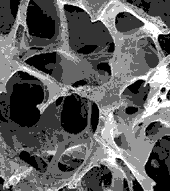Tissue Engineered Bone Grows Strong

Osteofoam™ scaffold <br>Molly Shoichet and John E. Davies Research Laboratories (U. Toronto) BoneTec Corp.
By closely following nature’s blueprint, Toronto researchers have developed an innovative way to speed the healing of severe bone breaks, resulting in what may be the thickest tissue-engineered bone ever produced in the laboratory.
The new bone grows naturally without the addition of chemical growth stimulants, said Whitaker investigator Molly Shoichet, Ph.D., of the University of Toronto. The innovation is in the design of the synthetic scaffold that provides a framework for the growing tissue.
The design mimics the structure of natural bone so faithfully that some experts in the field cannot distinguish between the two when shown micrographs of each side-by-side, Shoichet said. The research was published in the June 15 issue of the Journal of Biomedical Materials Research Part A.
“The structure is very open and porous,” she said. “There are large interconnections between the pores separated by struts, rather than solid walls.”
Into this spongy matrix, the researchers drizzle bone marrow cells, which can differentiate into osteoblasts, the strong, mineral-like cells of mature bone. The marrow cells take up residence in the scaffold and begin growing and multiplying. As they mature, the scaffold itself dissolves.
“You don’t need growth factors to get the cells into the scaffold,” Shoichet said. “The cells almost fall through it and get stuck along the way.”
The scaffold, developed with coinvestigator John Davies of the University of Toronto, is made of poly(lactide-co-glycolide), a polymer used in sutures. The polymer is processed in a unique way to yield the open, sponge-like structure with pores more than 10 times larger than those that result from conventional processing.
Animal studies show that the scaffold provides an intricate framework for dense new bone growth while it slowly dissolves. In rabbits, strong new bone completely replaced the scaffold in about eight weeks.
For some time, tissue engineers have experimented with scaffolds that promote bone growth. Much of this work has relied on supplementing the cell culture with growth hormones or other stimulating chemicals. Shoichet demonstrates a simpler, more natural way to grow new bone.
“To the best of our knowledge, bone growth throughout such a volume has not been reported before in the literature,” she said.
The University of Toronto has licensed the technology to BoneTec Corp. for commercial development under the trademark name of Osteofoam. Shoichet is a vice president of the company.
The Whitaker Foundation has supported Shoichet’s laboratory through a 1998 Biomedical Engineering Research Grant for research to encourage the regrowth of damaged nerve cells.
Contact:
Molly Shoichet molly@ecf.utoronto.ca, University of Toronto
Frank Blanchard frank@whitaker.org, The Whitaker Foundation
Media Contact
More Information:
http://www.whitaker.org/news/shoichet.htmlAll latest news from the category: Health and Medicine
This subject area encompasses research and studies in the field of human medicine.
Among the wide-ranging list of topics covered here are anesthesiology, anatomy, surgery, human genetics, hygiene and environmental medicine, internal medicine, neurology, pharmacology, physiology, urology and dental medicine.
Newest articles

Pinpointing hydrogen isotopes in titanium hydride nanofilms
Although it is the smallest and lightest atom, hydrogen can have a big impact by infiltrating other materials and affecting their properties, such as superconductivity and metal-insulator-transitions. Now, researchers from…

A new way of entangling light and sound
For a wide variety of emerging quantum technologies, such as secure quantum communications and quantum computing, quantum entanglement is a prerequisite. Scientists at the Max-Planck-Institute for the Science of Light…

Telescope for NASA’s Roman Mission complete, delivered to Goddard
NASA’s Nancy Grace Roman Space Telescope is one giant step closer to unlocking the mysteries of the universe. The mission has now received its final major delivery: the Optical Telescope…



